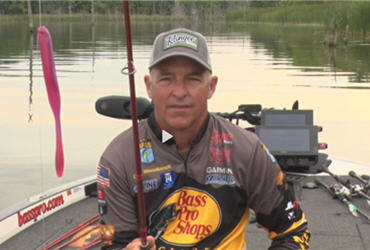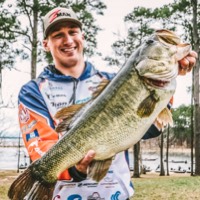During the late winter and early spring, while many anglers wait to take their boats out of storage until warmer weather arrives, Bass Pro Shops Cabela’s Fishing Pro Mike McClelland not only has his boat ready but a game plan in place also.
He’ll target floating docks, sawdust mats, and tire reefs looking for largemouth and spotted bass.
“In the spring, fish aren’t looking to eat but they’re looking to warm themselves,” McClelland started. “If you present the right bait at the right time, there’s definitely the opportunity to catch them.”

Fishing Pro, Mike McClelland
Breaking Down the Lake
For McClelland, anytime he’s fishing a lake in the US in the early spring, he’ll pick a section of the lake and break it down. One factor that helps him select one area over another is the presence of a tailrace because if one is present, the water will be warmer up the river.
On a natural lake that doesn’t have one, where the lake is going to be pretty consistent throughout the course of the lake, he’ll target the North side of the lake. He says the face of the lake won’t catch the north wind during the coldest months of the year.
“You have to do your research and figure out what section of the lake will come on sooner than the rest of the lake and you try to break it down,” McClelland said.
McClelland fishes the White River Chain of Lakes; Beaver Lake drains into Table Rock and Table Rock drains into Bull Shoals. Typically, the upper region of those lakes is the warmest as it flows out of the bottom of the lake with temps ranging between 48- to 52-degrees year-round when they are generating water through the dams.
Early in the spring, he’s witnessed extremely cold winters where the upper regions of those lakes have been in the upper 40’s love 50’s while the lower regions of the lake were in the upper 30’s low 40’s. That can dictate where he’ll fish.
“As you get into the spring and the water temps start to moderate a bit. I’ll focus on the northern banks of the lake because they don’t get beat up as much from the north wind and will be a few degrees warmer,” McClelland said.
Regardless of the technique, his cadence will be slow and methodical.
“Those fish are sunning and are not necessarily interested in feeding It’s all about getting the bait into the right position and coaxing them into biting. It’s going to be a slow methodical presentation,” he said.
Fishing Decaying Vegetation or Sawdust Mats

When fishing cold water, it’s all about finding the warmest water possible.
“Whether it’s sawdust mats or floating decaying vegetation, largemouth want to get under it because the heat of the sun heats that decaying vegetation,” McClelland said.
On the White River Chain of lakes he calls home, the winter will drive water temps into the upper 30’s and low 40’s. After the first 3 or 4 rains in the spring, after the lakes have been drawn down for winter, the spring rains produce sawdust mats that are formed in the back of pockets.
Once the run-offs cease and the sun comes out, bass will sun themselves to warm up and heat up the mats. Once the sun begins setting, bass will locate beneath those mats to maintain that same warm they’ve had while sunning all day, McClelland says.
McClelland is an outspoken proponent of the Panoptix feature offered on Garmin units because of versatile and efficient it makes him as an angler. “I can pull up into the back of a run-off pocket and actually look up under the sawdust mats and see if there are fish underneath,” he said.
All he needs is 3- to 4-feet of water beneath the mat that adds some “depth separation between the floor of the body of water you are fishing and the bottom of the mat”.

Very seldom does McClelland catch fish holding to the bottom beneath a sawdust map- most often they’re suspended just under the mat.
Often, he’ll use a jig and chose its size based upon what’s needed to penetrate the mat. After he gets the jig through, he will not allow it to go all the way to the bottom. Instead he’ll pull the jig up just beneath the bottom of the mat as that is where the bass will be holding to feel the heat permeating from the mat.
Fishing on Floating Boat Docks
Experience has taught McClelland that the most important part of fishing a dock in cold water is the material used to keep it afloat.
McClelland only fishes docks that have dark colored floats.
“It’s all about the warmth that that black float absorbs the sunlight through the course of the day so it is going to radiate heat even through the course of the day once the sun falls away from it just like the sawdust mats,” he said.

Garmin ECHOMAP 126sv Chartplotter/Fish Finder Combo
There are times when bass will suspend under docks and for whatever reason it really intimidates anglers McClelland says. “As long as you know the range the fish are trying to be at and have the ability to analyze that with Panoptix on my bow-mounted Garmin GPSMAP 7610 chartplotter fishfinder combo unit, it makes suspending fishing just like any other fishing you do. It’s all about presenting a bat at the right depth,” he said.

Panoptix LiveVü Down providing sonar images of fish hiding under overhead cover.
 Berkley Skinny Cutter 110+ Shallow Jerkbait
Berkley Skinny Cutter 110+ Shallow Jerkbait
He has found that sometimes a big soft-plastic swimbait works better when bass are holding deeper.Fishing the Tire Reefs in Mid-West LakesIn the mid-west, many lakes have wind breaks and reefs built from industrial machinery tires. McClelland reasoned that anything dark in color absorbs heat from the sun and so, anything dark in color that absorbs heat from the sun can definitely be attractants to the fish early in the spring when the water is cold.McClelland’s Bait Color ChoicesHis bait colors will be dictated by forage. When targeting docks, he’ll select shad colored baits as that’s what they’ll be feeding on. Bright sunny conditions and clear water call for ghost and transparent colors that the sun can pass through.Dingy water means that opaque colors providing plenty of flash like Chrome Shad and Old Glory excel.
Bass Pro Shops Micro Lite Graphite Casting Rod
When fishing mats, McClelland knows that they’ll be feeding brim (bluegill) or crawfish- flipping baits colored green pumpkin and black blue excel.Gearing Up to Match the TechniqueUsing a variety of Falcon fishing rods in his signature series the Falcon Cara Micro rod line ranging from 6-8 to 7-4, that he’ll match to the technique. He’ll always throw the 6-8 jerkbait rod to allow him to best work the bait while a 7-2 rod helps make the longer casts required to fish a swimbait effectively. A 7-4 heavy action rod works best for McClelland when targeting thick vegetation.He’s exceptionally selective about the types of line that he uses for specific techniques. When fishing a jerkbait in cold water, he prefers Sunline Super Natural Nylon Monofilament fishing line in cold water but as the water warms, he’ll switch to 10- to 14-pound Sunline FC Sniper or Shooter line. The latter is a fluorocarbon that has even less stretch helping for driving the hooks home and when the bite is light to assist with detecting bites.When probing light vegetation, 20- to 25-pound Sunline Super FC Sniper fluorocarbon line gets the job done while thicker vegetation calls for Sunline Siglon Pex8 50- to 65-pound FX braided fishing line.
This is a tactic that will score not only with largemouths but also other gamefish like crappies, white bass, hybrids, and stripers. You can use vibrators, tail-spinners, blade lures and plain jigs, but the best lure for vertical jigging is a hammered metal spoon such as a 1/2-1 ounce size Hopkins No=EQL Lures or Bass Pro Shops Strata spoon. Find fish on a depth finder or locate good structure where you’ve caught bass in the past. Then lower the spoon down to the bottom or where fish show on the sonar.
Start with a short lift and drop presentation. Raise the spoon 12-24 inches and then let it flutter back down like a wounded shad.
Tip: Watch for strikes as the lure descends. The line might shoot sideways or simply stop falling. Other times you might feel a slight tap or jerk. Set up fast.
Extra Tip: If strikes don’t come, try longer lifts of the rod, as much as 3-4 feet, letting the lure fall freely back down afterwards. Make sure excessive slack doesn’t form in the line, though, or you may miss strikes on the “drop.”
Bass Pro Shops Strata Spoon Lure
6. Bonus Tips for Winter Bass Outings –
1. Use a thermometer to check the water temperature. Some parts of a lake may be 42 degrees while other areas are only 38. That four degrees can make a huge difference in your catch rate.
2. Concentrate on northern and northeastern shorelines. They receive the most sunlight and warm more quickly from southerly winds.
3. Cast to boat docks with metal roofs and exposed rocks. They soak in the sun and convey warmth back into the water, attracting baitfish and bass.
4. Always wear your life vest. Cold water can cause hypothermia quickly.
5. Wear sunscreen. The UV rays can damage skin just as badly in winter as in summer.
6. Dress in layers so you can adjust clothing you wear as the day warms.







